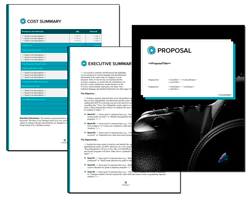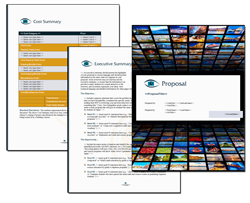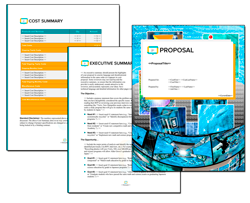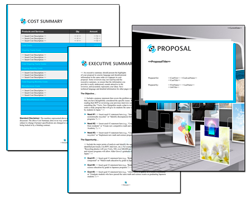
How to Write a Photography or Media Services Business Proposal: Tips and Techniques
Do you need help writing a proposal for photography or media services? Aligning the proposal with the client's goals is crucial for success. This guide provides a step-by-step approach to writing proposals that get results. From understanding client needs to creating a stunning cover page and outlining your services, Proposal Kit has you covered.
Key Takeaways
- Conduct thorough research on the client's industry and needs to tailor your proposal effectively, ensuring it aligns with the client's goals, vision, and objectives.
- Present a visually appealing and professional proposal with a stunning cover page, high-quality images, and a well-organized layout highlighting your unique qualities and services.
- Clearly outline your project timeline and pricing structure to set realistic expectations and foster trust. Include testimonials and a call to action to encourage client engagement.
Understanding the Client's Needs

A successful proposal involves understanding your prospective client's specific challenges and expectations. Rather than merely offering services, it customizes them to cater to clients' needs and goals. Conduct thorough research on the client's industry to gather insights to make your proposal more relevant and persuasive.
Critical steps in this process are determining the project scope and asking questions to understand the client's needs. These actions help you define the objectives, target audience, and messaging, ensuring that your proposal aligns perfectly with the client's vision and needs. This section details these steps, providing a roadmap to creating a proposal that stands out by incorporating client feedback.
Research the Client's Industry
A thorough market analysis of the client's industry is necessary for customizing your proposal. Focus on understanding industry trends, competitors, and unique challenges. Search for images online in the client's industry to understand what types of images, shot angles and key features are commonly used. This can help you decide on a more standard conservative shooting approach or a bolder approach yet still capturing what is essential to that market.
This knowledge allows you to propose targeted solutions that resonate with the client, demonstrating your professionalism and understanding of their situation.
Identify the Project Scope
To identify the project scope and deliverables, you must detail the specific goals, target audience, messaging, budget, and timeline. Clearly defining these elements provides a comprehensive overview that helps clients understand how your services align with their business objectives. This step is crucial for setting clear expectations and ensuring that both parties are on the same page.
Ask Key Questions

Asking pertinent questions is necessary to understand the client's needs and objectives. Open-ended questions allow for deeper insights, helping you identify gaps and opportunities in the client's current situation. Essential questions include the number of shots needed, the concept or style desired, and the deadline.
This information ensures your proposal is tailored to meet the client's specific requirements based on client feedback.
Creating a Stunning Cover Page
First impressions matter, and the cover page of your proposal is what a potential client sees first. A stunning cover page sets the stage for the entire proposal, reflecting your business in a way that enhances its visual appeal. It should catch the client's attention and make them eager to read more.
Critical elements of a cover page include:
- A consistent color scheme
- Typography
- A striking hero image
- Branding elements like your company name and logo
These elements are essential for building brand awareness and ensuring your proposal stands out.
Include Your Company Name and Logo

Prominently featuring your company name and logo on the cover page aids in promoting brand recognition, projecting professionalism, and reinforcing your brand identity. This ensures your proposal is easily recognizable and highlights your company's unique qualities.
A strong logo can differentiate your business from competitors, showcasing uniqueness and building brand loyalty.
Use High-Quality Images
Visual storytelling with high-quality images is indispensable for representing your brand's style and expertise. These images demonstrate the level of professionalism and quality that clients can expect from your services. Incorporating such images into your cover page reflects your attention to detail and commitment to excellence.
Stock images in pre-made templates should be replaced with your photos for a completely custom look. Proposal Kit's photography and media-based templates are designed to be customized by setting a color scheme, typography, logo design, and imagery that matches your company's look.
The client should see the same quality in the visual presentation of your proposal that they would expect to see in the work you deliver to them. A proposal with low production quality will not inspire confidence.
Writing a Personal Introduction
A personal introduction sets a positive tone for the rest of the proposal, aiding in building rapport and a client relationship. It differentiates your company from competitors, making clients feel valued and giving you a competitive edge. This section should establish a warm and inviting tone, showcasing your unique photography style and personality.
Establishing trust is critical for high-level transactions, and personal connections with clients are the foundation for this trust. Recording notes on clients in CRM software can help personalize future interactions, ensuring you remember their preferences and needs.
Highlight Your Unique Qualities
Emphasize any specialized skills or certifications that give you a competitive advantage over other professionals. Showcase unique methodologies or tools you use to deliver exceptional results. Including thought leadership pieces or custom samples in your portfolio can further demonstrate your expertise and dedication.
Establish Credibility

When selling intangibles, where personal credibility translates into company credibility, it is important to establish credibility through client testimonials. Share specific metrics or key performance indicators from previous projects to demonstrate your effectiveness and build trust.
A well-organized digital marketing portfolio can also help establish credibility and trust with potential clients or employers.
Detailing Your Services
Outlining your service offerings in an executive summary fosters trust and sets precise expectations. It ensures everyone is on the same page and provides an overview of the services offered. This section should break down each service and use visual aids to make the information more digestible.
Clients should understand what each service entails to avoid confusion and ensure transparency. Clear service descriptions illustrate the value of each service, making it easier for clients to see the direct benefits and applications.
Break Down Each Service
The value proposition of each service enables clients to perceive the specific value in various activities and understand the deliverables. This level of detail demonstrates your thorough understanding and professionalism, helping to justify the pricing and showcase the comprehensive nature of the services provided.
Use Visual Aids

Visual content such as infographics or illustrations can be incorporated to demystify complex information and render it more accessible. Visuals help capture and maintain client interest, making the information more digestible and engaging.
This approach enhances readability and helps avoid confusion by clearly communicating the details of each service, making it more than just a list.
Showcasing Your Portfolio
A portfolio presentation, an essential part of a proposal, manifests your abilities and style to the client. Selecting the right images for your portfolio is crucial because they need to match what the client is looking for and showcase your style and skills. This section will guide you in selecting relevant work and creating a visually appealing layout.
Maintaining an up-to-date and well-organized portfolio indicates your active involvement and passion for your work. Including case studies and examples of successful campaigns can highlight your accomplishments and the positive impact of your work.
Select Relevant Work
Selecting pieces of work that resonate with the client's requirements for a compelling portfolio is vital. To enhance effectiveness, align your portfolio with the job description or project requirements.
For instance, for a corporate event, the portfolio should include pictures from similar events that have already been photographed, showcasing the efficiency of their photography services and photo delivery.
Create a Visually Appealing Layout
A visually appealing layout with well-chosen design elements can notably bolster a client's initial impression. Select images that align with your proposal's content to create a cohesive and engaging presentation. This approach makes your portfolio more attractive and helps convey professionalism and attention to detail.
Outlining the Project Timeline

Outlining the project timeline and milestones is imperative to displaying your working style and establishing expectations upfront. A well-defined timeline helps clients understand how the project will be structured and provides a clear roadmap for project tasks. This section will cover setting milestones and including buffer time to account for unexpected delays.
Clients can expect the following from your project completion process:
- Project completion within a specified number of days, helping to set realistic expectations from the outset
- Milestones and check-ins to keep the project on track and clients informed
- Alignment between all parties throughout the project's duration
This process ensures a smooth and successful project completion.
Set Milestones
Project phases and clear milestones facilitate progress tracking and the achievement of goals. Milestones serve as check-ins to ensure the project progresses as planned and allow for necessary adjustments.
Breaking down milestones into smaller tasks makes managing and tracking progress easier.
Include Buffer Time
Contingency planning, including buffer time in the project timeline, permits flexibility should unexpected delays or changes occur. This ensures that deadlines are met and the overall schedule remains on track. Buffer time can also provide flexibility in case of unforeseen challenges or additional client requests.
Presenting Your Pricing Structure
The presentation of a transparent pricing structure and cost breakdown fosters a robust connection and trust with the client. Itemizing costs helps clients understand what they are paying for and the value they receive. This section will guide you through itemizing costs and clearly explain payment terms.
A clear pricing model justifies client costs, enhancing their appreciation of the strategy and creativity involved. Clearly explaining payment terms, including:
- The method
- Schedule
- Deposits
- Conditions for final payments
Ensuring clarity in communication is crucial to winning business, avoiding confusion, and providing a smooth transaction.
Itemize Costs

Pricing packages itemized based on services such as content creation, strategy planning, community management, media campaign execution, and creative fees help clients better understand the required investment.
Clearly outlining payment packages and what each entails aids clients in understanding the value of the services provided.
Explain Payment Terms
Clearly explaining payment terms, including pricing, payment options, and payment schedule, is essential to avoid confusion and ensure a smooth transaction with clients. This transparency helps build trust and fosters a strong business relationship.
Including Testimonials and References
The inclusion of client reviews, testimonials, and references not only builds credibility but also highlights your strengths. Testimonials act as social proof, demonstrating customer satisfaction and building trust in your services. This section will cover how to share client testimonials and provide references.
Social proof is powerful; studies show that customers trust businesses more if they see positive reviews and testimonials. Including client testimonials can address potential customer concerns and showcase how others have benefited from your services.
Share Client Testimonials
Customer feedback, including client testimonials from past clients, can significantly boost your credibility. Select relevant, authentic, and specific testimonials to your target audience. These testimonials highlight your strengths and successes, providing social proof that can persuade potential clients.
Provide References

Offering professional references who can speak to your professionalism and results can reinforce the credibility of your proposal. Ensure that these references are individuals who have firsthand experience with the quality and reliability of your services.
Adding a Call to Action
A well-written call to action (CTA) is essential for guiding clients toward their desired next steps. It serves as a bridge, connecting the client to their goals by prompting them to take action, such as contacting you or starting a project. Including a clear and compelling CTA in your proposal can significantly impact decision-making. This section will cover how to encourage contact and provide complete contact information.
An effective CTA should clearly outline the client's next steps. The closing section of the proposal should encourage potential customers to contact you for further discussion and provide all the necessary information to do so.
Encourage Contact
Including phrases like "Contact us" or "Get started" in your CTA can prompt clients to contact you for more information or to begin a project. A phrase like "We look forward to discussing this proposal further" can motivate the client to take the initiative and contact you.
Ensuring your CTA buttons or phrases are highly visible can significantly improve the chances of clients finding and using your contact details.
Provide Contact Information

Providing complete and easy-to-find contact information through various communication channels ensures the client can effortlessly reach out for further inquiries or next steps. Including multiple contact options, such as email, phone number, and social media profiles, can enhance the client's ability to connect with you quickly.
Ensure that your contact information is prominently placed and includes multiple ways to reach you, such as phone number, email, and company website.
Using Proposal Templates
Using a photography proposal template with customization software can expedite the creation of your photography proposal and media business proposals, conserving time and effort. Proposal Kit provides customizable templates that help ensure consistency and professionalism across different proposals, giving clients a clear and structured understanding of the proposed strategy. This section will discuss the benefits of templates and how to customize them to fit your brand.
The Proposal Kit's Wizard software helps build custom proposals and calculate line-item quotes and schedules.
Templates allow you to focus more on creating compelling content rather than starting from scratch every time. They provide a pre-formatted structure for:
- Goals
- Strategy
- Target audience
- Content plan
- Budget
- Portfolio
This ensures a professional appearance that helps create a strong impression on clients and stakeholders.
Here are some related samples included in every downloadable Proposal Pack
The AI Writer generates a first draft of these templates - customized to your company, client, and project - in just minutes, giving you a head start on editing. Get any Proposal Pack or Proposal Kit Professional, and all of these samples, and the AI Writer are included.
Here are some related downloadable templates
The AI Writer generates a first draft of these templates - customized to your company, client, and project - in just minutes, giving you a head start on editing. Get any Proposal Pack or Proposal Kit Professional, and all of these templates and the AI Writer are included.
- Commercial Photography Services Proposal
- Event Photography Services Proposal
- Fashion Photography Services Proposal
- Movie Film Production Proposal
- Movie Pitch Proposal
- Photography Services Proposal
- School Photography Services Proposal
- TV Pilot Program Proposal
- TV Production of an Event Proposal
- Video Production Services Proposal
- Corporate Photography Proposal Template
- Corporate Video Proposal Template
- Corporate Video Services Proposal Template
Benefits of Using Templates
Templates guarantee consistency and professionalism across proposals, which is vital in providing clients with a clear and structured comprehension of the proposed strategy. Templates save time by allowing quick customization with pre-existing structures, letting you focus more on creating compelling content.
Proposal Kit provides an array of templates, design themes, layouts, and software to suit various needs.
Customizing Templates
To ensure brand consistency, proposal templates must be customized with your company's logo, colors, and fonts.
Proposal Kit's Wizard software efficiently builds custom proposals from an extensive template library.
Summary
In summary, writing a photography or media services business proposal involves a well-defined strategy and a series of well-thought-out steps. From understanding the client's needs and creating a stunning cover page to detailing your services and showcasing your portfolio, each element plays a vital role in creating a proposal that captivates and convinces your client. Outlining the project timeline, presenting a transparent pricing structure, and including testimonials and references further build trust and credibility with prospective clients.
Templates can streamline the proposal process, ensuring consistency and professionalism while allowing customization to fit your brand and client's needs. By following these best-in-class tips and techniques, you can create proposals that meet and exceed client expectations, ultimately helping you win more business and close more deals.
 Proposal Kit Professional provides the most content, including legal contracts and a free design theme pack. Plus, advanced software features include custom branding and customizable quoting databases.
Proposal Kit Professional provides the most content, including legal contracts and a free design theme pack. Plus, advanced software features include custom branding and customizable quoting databases. Proposal Pack for Any Business covers this type of proposal and includes samples. There are also some commonly used specialty design themes available:
Proposal Pack for Any Business covers this type of proposal and includes samples. There are also some commonly used specialty design themes available:Photo Design Proposal Packs
Line Art Design Proposal Packs
 Proposal Pack Communication #1
Proposal Pack Communication #1 Proposal Pack Computers #1
Proposal Pack Computers #1 Proposal Pack Entertainment #1
Proposal Pack Entertainment #1 Proposal Pack Entertainment #4
Proposal Pack Entertainment #4 Proposal Pack Entertainment #5
Proposal Pack Entertainment #5 Proposal Pack Entertainment #6
Proposal Pack Entertainment #6 Proposal Pack Entertainment #7
Proposal Pack Entertainment #7 Proposal Pack Multimedia #1
Proposal Pack Multimedia #1 Proposal Pack Multimedia #2
Proposal Pack Multimedia #2 Proposal Pack Multimedia #3
Proposal Pack Multimedia #3 Proposal Pack Multimedia #4
Proposal Pack Multimedia #4 Proposal Pack Photography #1
Proposal Pack Photography #1 Proposal Pack Photography #2
Proposal Pack Photography #2 Proposal Pack Photography #3
Proposal Pack Photography #3 Proposal Pack Photography #4
Proposal Pack Photography #4 Proposal Pack Photography #5
Proposal Pack Photography #5
Frequently Asked Questions
Why is understanding the client's needs crucial in a proposal?
Understanding client expectations is essential because it ensures your proposal is tailored to address their specific challenges and expectations, making it more relevant and persuasive. It also helps build a strong connection with the client and increases the likelihood of winning the business.
What elements should be included on the cover page of a proposal?
A proposal cover page should include a consistent color scheme, typography, a striking hero image, and branding elements like your company name and logo to create a strong visual impact and brand awareness.
How can I make my portfolio more effective in a proposal?
To improve portfolio effectiveness in a proposal, select relevant work that matches the client's needs and create a visually appealing layout that aligns with your proposal's content. Including case studies and successful campaigns can highlight your accomplishments.
Why is it essential to include a call to action in a proposal?
Including a call to action in a proposal is important because it provides actionable steps that guide clients toward the desired next steps and can significantly impact their decision-making process.
What are the benefits of using proposal templates?
Proposal templates offer efficiency, consistency, and professionalism in proposals. They save time and effort while providing a pre-formatted structure for essential components like goals, strategy, and budget. This allows you to focus on creating compelling content without starting from scratch.



 Cart
Cart
 Are you just looking for a template, sample, or software for your photography and media proposals? Click these links to skip down the page and get right to it.
Are you just looking for a template, sample, or software for your photography and media proposals? Click these links to skip down the page and get right to it.





 Facebook
Facebook YouTube
YouTube Bluesky
Bluesky Search Site
Search Site